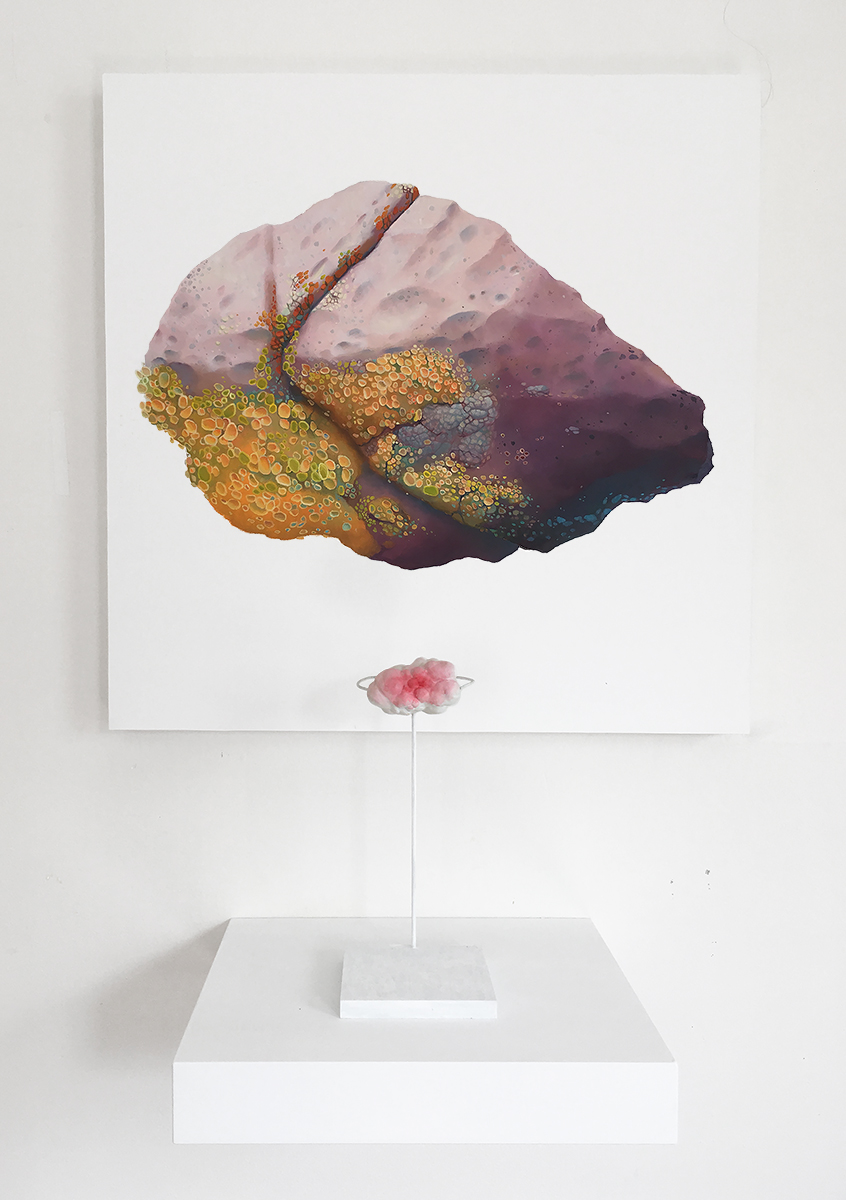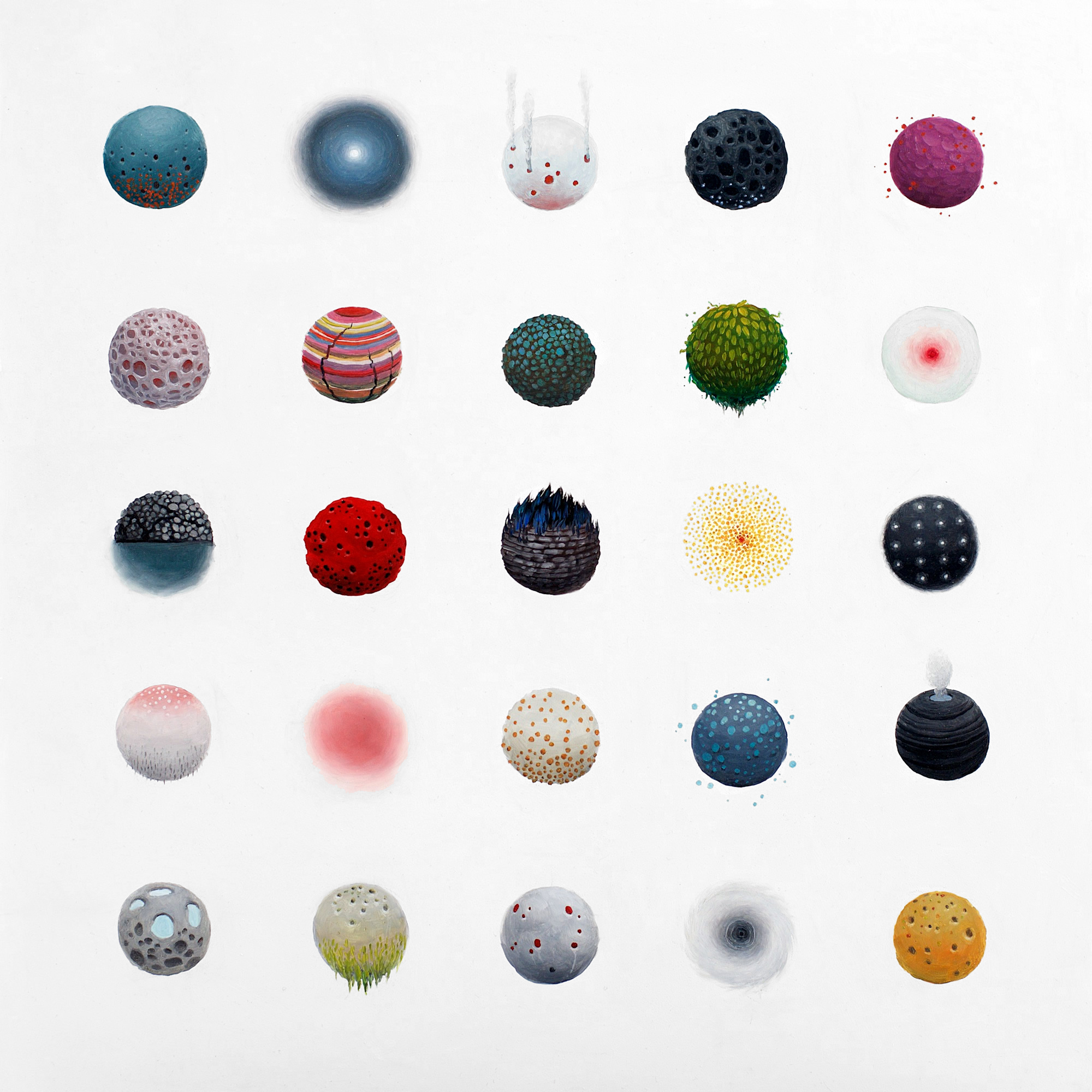
Rudiments, oil on panel, 18 x 24 inches, and sculpture: clay, gouache, wire stand
Adoration, Observation and Visual Ecology: Ashley Eliza Williams Wishes to Speak with the Growth in the Forest
Interview by: Olivia Ann Carye Hallstein
Ashley Eliza Williams is practicing through careful study, observation, and sentience, the ability to communicate with the building blocks of the natural world. She is at one with the lichens, mosses, lithophytes, and most solid rocks of the forest. Her visions are filled with future ecologies based on the tales and dreams of both the oldest forebearers and the most adaptable around us. I had the pleasure of asking her questions to her practice…

Resonant, oil on panel, 40 x 30 inches
Dear Ashley, in your process of seeking sentience in the natural world, what have you found so far and what has most surprised you?
Although a rock in the forest isn’t “alive” by any scientific metric, it hosts an ecosystem of beings with relational and sensory capacities: lichens, mosses, insects, small mammals, bacteria, algae, and other lithophytes. These beings sense the world and interact with each other in wildly different ways. In a certain sense, when you contemplate a rock, you are in dialogue with an entire community of sentient beings. This feels magical and incredible to me, but it is very real.

Index Fossil, oil on panel, 20 x 20 inches, and sculpture: wire stand, gouache
I believe you, perhaps we are not listening closely enough. In the visual depictions of your findings, you often choose a chart format for your compositions. What has led you to explore this representational form and what role does color choice have in what you are representing?
I’ve always loved field notebooks and scientific charts. I think they are beautiful and I’m fascinated by the kinds of information scientists have chosen to record throughout the ages. Why is one piece of information more important than another? What do these choices say about an individual scientist, the cultures that we are a part of, and our anthropocentric worldviews? Being an artist gives me an excuse to play with and think about these questions.
Since 2014, I’ve been using color charts to try to abstract or distill experiences in nature and my attempts at interspecies communication. My latest project is an attempt to communicate with a lichen. I’ve been visiting the same patch of lichen every day. Each day, I create a color strip that reflects my experience with the lichen. I’ve visited the lichen in the evening, in the morning, in the middle of the night, when I’m feeling hopeful, and when I’m depressed. Each time I interact, I mix a very specific color to describe that interaction. The colors are a record of my many (and mostly failed) communication attempts.

Convergence Studies 2, oil on canvas, 20 x 20 inches
Beyond your process, how much of your work is scientific explorations, spiritual findings, and fantasy?
It’s a mix of real and imagined. My partner is a scientist, and my projects often involve working closely with scientists in the field. But I also love imagining potential future beings and ecologies. I believe that there is a link between the human imagination and biodiversity. Artists who care about ecology need to be wild dreamers and we need wild landscapes to be able to dream. I think it’s important to imagine what a healthier future ecology might look like. What animals, plants, and ecosystems will exist in the future if we don’t drive everything to extinction? Most of the images I paint and sculpt are imaginary or highly abstracted. But they are built on a foundation of obsessive observation, research, a love of wild places, and my deep respect for and curiosity about all living beings, especially those that are quiet and easily overlooked.

Nucleus, oil on panel, 18 x 24 inches, and sculpture: clay, wire stand, cut paper, gouache, coral
Thank you, Ashley. And good luck with your incredible interspecies goals. We have a lot to learn from this earth.